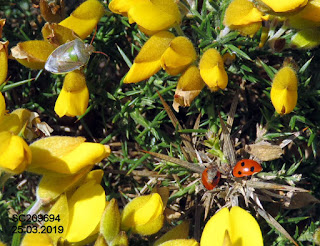I am old enough to remember the days when yellow fly papers hung down from the ceilings in my grandparents' houses! These sticky rolls attracted lots of flies which got stuck on the tape and when full would be disposed of. Lots of people used these tapes but we didn't have them at home. Instead my mother dashed round with an aerosol spray, probably full of toxins that were just as harmful to humans.
People now reminisce about having to clean car windscreens of insects on long journeys and, yes, I remember that too. The point I am making is that flies were a problem back then in the 50s. We may still get the odd bluebottle indoors in the summer when the windows are open but an old fashioned flypaper would probably last us 12 months now. So when did things change? And what caused their decline?
More to the point, what has all this got to do with Ballachurry Reserve? Well on Monday I was invited to join the Island's dipterist, Steve Crellin, down at the Reserve. Steve identifies and records the various flies we have here on the Isle of Man. Recording the abundance or otherwise of any insects, flies included, can reveal how healthy our bio-diversity is. Many of these flies are also pollinators and we are all aware how important pollination is to our own well-being. Then there is the food chain - do you remember the old nursery rhyme about the old lady who swallowed a fly? She swallowed a spider to catch the fly, then a bird to catch the spider etc. etc. All sorts of creatures eat flies, not just spiders. Frogs, birds and even some small mammals. And don't forget that before they emerge as an adult fly these creatures are juicy maggots - just a different meal at another time of year. I may have to slap on the Jungle Formula when walking round the reserve in summer, but I am always very happy when Ballachurry is a-buzz with insects.
Steve is going to let me have a full list of what he found at the reserve in due course. I'm sure there will be a new record or two among them. He has, of course, kindly been identifying the Ballachurry species for a couple of years now, based on the photographs I post on the Blog but there is no substitute for identification in the field and indeed some species can only be identified by microscopy.
Whilst waiting for the full list here are some photos from a fascinating afternoon at Ballachurry Reserve.
 |
| essential equipment - a sweep net |
 |
| checking the catch - did it get away? |
 |
| the fly then has to be sucked into a plastic tube with a pooter the only way to do this is to get up close and personal! |
 |
| safely potted, the fly can be examined with a hand lens |
 |
| this one had lovely iridescent colours |
 |
| as can be seen in close up |
 |
| some are easily caught |
 |
| or can be identified from afar |
 |
| without needing to catch them Syrphus species (probably torvus) |
 |
| Yellow Dung Flies don't look too attractive when sitting on a cow pat, but this one was doing a good job probably pollinating the blackthorn |
 |
| see its hairy legs? I watched it for some time meticulously running its proboscis over the petal vacuuming up the fallen pollen |
 |
| one of Ballachurry's most prolific species of Hoverfly last year Eristalis pertinax |
 |
| I rarely stop to look at the scum that accumulates by the bridge but shall be taking a closer look in future |
 |
| dozens of these little Chironomidae flies were on the surface and we saw a water beetle vanish into it too |
SC209694 Eristalis pertinax Hoverfly
SC209694 Peacock Butterfly; Small Tortoiseshell Butterfly;
SC 209694 8 x 7-spot Ladybirds
SC209694 10+ Gorse Shieldbugs and 2 x Sloe Shieldbugs ( also known as Hairy Shieldbugs)
SC209694 Robin & Blue Tit
SC209694 ( hide) 3 x Mallard drakes; Wren; Great Tit.
SC209695 3 x 7-spot Ladybirds
SC209695 Blue Tit; Great Tit.
SC208694 Chiffchaff heard but not seen; 2 x Long Tailed Tit; male Chaffinch
SC208694 unidentified water beetle
SC208694 numerous Chironomidae flies on surface scum
SC209693 2 x Blackbirds; Wren
SC208694 Marsh Marigolds now in flower in the damp meadow
SC209695 about 10 Water Crickets.
SC208694 Marsh Marigolds now in flower in the damp meadow
SC209695 about 10 Water Crickets.
 |
| Water Cricket |
 |
| 7-spot Ladybird |
 |
| 7-spot Ladybird |
 |
| Marsh Marigolds now flowering |
 |
| Gorse Shieldbugs |
 |
| Gorse Shieldbug and 2 x 7-spot Ladybirds |
 |
| Gorse Shieldbug |
 |
| Mallard Drakes |
 |
| Long Tailed Tit |
 |
| Robin |
 |
| Sloe Shieldbug |
 |
| another Sloe Shieldbug |
 |
| Sloe Shieldbug - closer view |
 |
| Small Tortoiseshell |
My thanks to Steve for a really interesting afternoon.
(please remember that clicking on a photo will enlarge it)
(please remember that clicking on a photo will enlarge it)












































